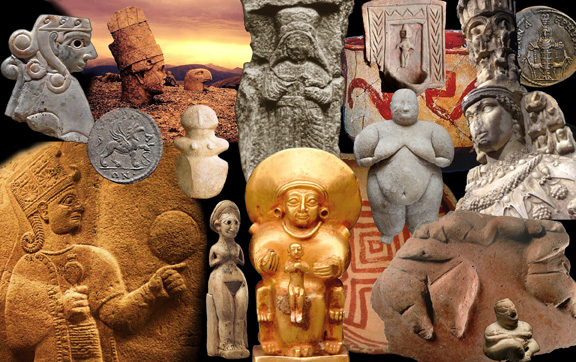Upcoming livecasts and events
Snake Women visual livecast 
A visual journey with goddesses, ancestors, shapeshifters, seeresses and priestesses. We look at rock art from Australia, Brazil, Utah, and South Africa; seals from eastern Iran, Canaanite gold, Egyptian stelae, Aztec statues, and masks from Nigeria to Ivory coast. We’ll go into the continent-spanning theme of the woman who grasps serpents in both hands, and also she who is belted with snakes. We'll discuss the python oracles of Greece, Malawi, and Surinam, and view snake goddesses from Egypt, Mexico, Germany, China, India, Benin Republic. Also, snaky women from the Inland Delta of the Niger (Mali), Argentinian bronzes, Frankish ivories and Romanesque churches. It’s a free-for-all of fairies and saints, witches and wu, Mami Wata and Santa Marta la Dominicana.
Anatolia visual livecast
Female icons from the 7th millennium bce to bronze age. Hittite, Phrygian, Lydian goddesses: Wurusemu, Hannahanna, Shauskha, Kybele, Upis/Artemis Ephesia. Potters, farmers, and priestesses. Asia Minor has a long and very rich archaeological record, from Göbekli Tepe and Çatal Höyük through the neolithic, and on to Kultepe, Alaça Höyuk, Troy, Arslankaya, Ephesos and Sardis.
Ceramica: Women's Art and Symbols visual livecast
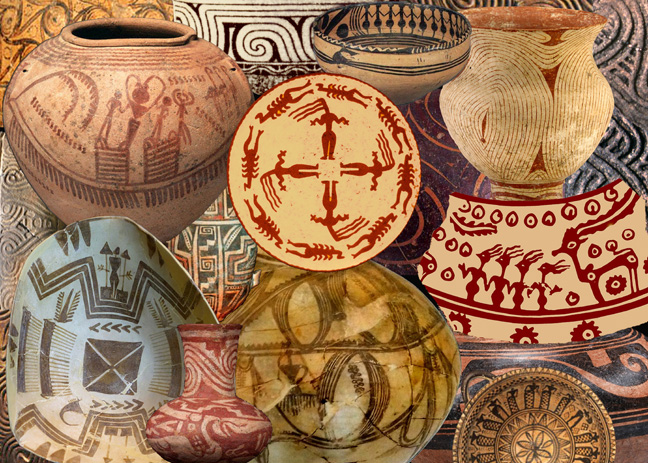
Painted, incised and modeled ceramics are a rich reservoir of sacred signs that go back many thousands of years. They open a window into ancient women's dance, ceremony, and spiritual culture. These women were culture-makers who also sculpted breastpots, motherpots ("female effigy vessels"), and animal pots. The visual talk surveys archaeological finds from Iraq, Pakistan, Egypt, Romania, China, Mexico, Greece, Brazil, Arkansas, Thailand, Iran, Arizona, Sudan, and Costa Rica, and many other countries. We also look at living traditions, for instance from Pueblo artists, Mangbetu potters in Congo, and Shipibo painters in the Peruvian Amazon.
Shown: foreground images, L to R): Egypt, Iraq, China and Thailand (top row); down to Pakistan and Greece, and L to Romania, Arkansas and Iran. Background images: Crete, Brazil, Georgia (North America), Costa Rica; and in the center, left to right, Argentina and China.
Witches and Pagans: Down to the Roots visual livecast
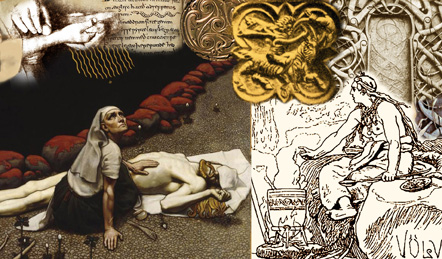
The spiritual heritages of pagan Europe were carried along by wisewomen, healers, seers, enchantresses, and nightfarers. This visual talk looks at folk names for the witch and the female sacraments of spinning, weaving, herbcraft, divination, incantation, and sacred dance (and priestly persecution of all that). We look at legendary witches in Ireland, Czechia, Scandinavia, and the Witches' Goddess in Germany, Italy and France. And call up memory of the Fates, fatas, faeries, and the “women who go by night with the Goddess" in spirit flight across the lands.
Shown, from left top and around: Healing with stone in Hungary; Anglo-Saxon healing charm; Moylough healing belt, Ireland; witch in flight, France; tree of life portal, Norway; Iceland völva sitting out for a vision; Finnish healer bringing the spark of life back into a dead man.
Witch Hunts
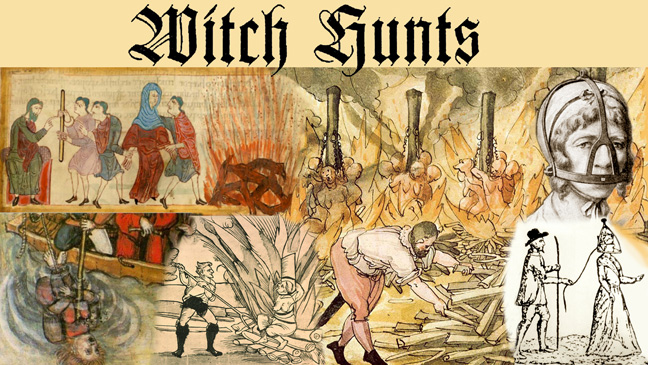
We honor ancestors who fell to the witch-hunting Terror, the crucible of modern “Western Civilization.” The witch hunts had a profound impact on women’s freedom—speech, professions, bodies, sexuality, and mobility in public spaces. Yet witch hunts have become a metaphor without their own significance ever having been understood or digested. Women, the old, poor, disabled, queer, and ethnic minorities were targeted as “devil-worshippers.” (And some victims really were healers, midwives, and diviners—or bold, indominable women.) We look at how the witch craze was escalated through torture-trials; who was persecuted; and the role of rulers, churchmen, doctors and professors in propagating misogynist persecution. How did witches’ bridles, sexualized torture, and racist diabolist ideology influence European culture, and get exported as tools of colonization? What are the legacies of this repression today? It’s crucial for us to understand this prehistory of modern patriarchy and empire, which still influences the dominant culture today.
Sun 1 Nov at noon (PST, San Francisco time, UTC-8).
Snake Women visual livecast
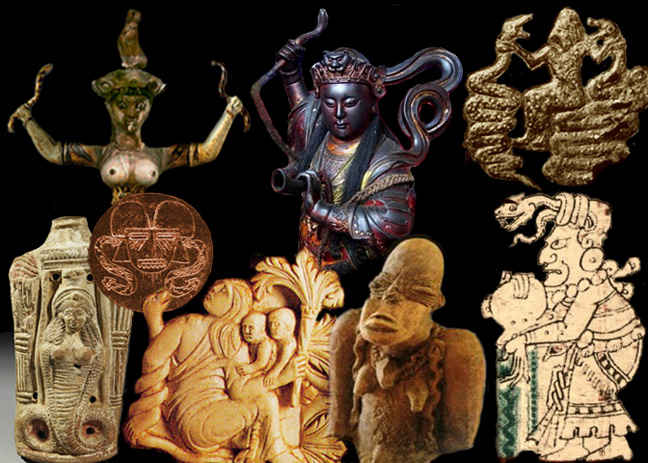
A visual journey with goddesses, ancestors, shapeshifters, seeresses and priestesses around the world. We look at rock art from Australia, Brazil, Utah, and South Africa; seals from eastern Iran, Canaanite gold, Egyptian stelae, Aztec statues, and masks from Nigeria to Ivory coast. We’ll go into the continent-spanning theme of the woman who grasps serpents in both hands, and also she who is belted with snakes. We'll discuss the python oracles of Greece, Malawi, and Surinam, and view snake goddesses from Egypt, Mexico, Germany, China, India, Benin Republic. And snaky women from Mali's Inland Delta of the Niger, Argentinian bronzes, Frankish ivories and Romanesque churches. It’s a free-for-all of fairies and saints and ancestors, Chinese wu and Santa Marta la Dominicana.
Shown, from left top and around: Crete; China; Iran, Guatemala, Mali, Francia, Argentina, Egypt.
Sacra Vulva
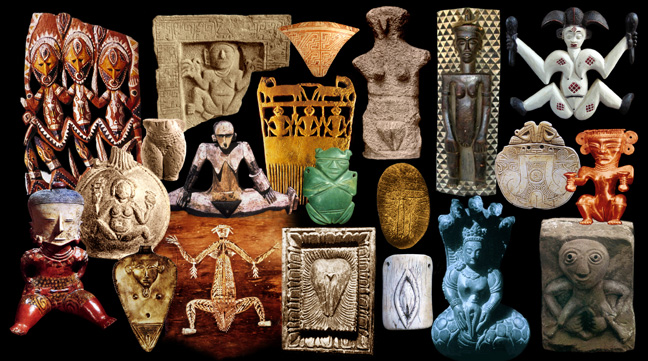
A very international view of ancestral women, sheela-na-gigs, Tantrik murthies, nagas, zemis, amulets, rock art, ceramics, and sculpture in wood, stone, and ivory. Vulvas engraved on the bones of Earth, signs of origin grooved into the rock by ancient hands; the place of Emergence painted with the blood of Earth, the blood that is life, coursing vitality: in remembrance of ancestors or the Creation in time-out-of-time. The Woman who stands at the Portals, who has within her an opening into the vastness, the Origin which is everywhere at the center. http://www.suppressedhistories.net/events.html
From left at top: Vanuatu, Ecuador, Brazil, Iroquoia, Cyclades, BaPende Country, and Gabon. In the middle: Egypt, Elam / SW Iran, Belau, Costa Rica, Rapa Nui, Dominican Republic, Colombia; at bottom: Nayarit / west Mexico, Canaan, Yolgnu Country Australia, south India, Congo, Nepal, and (I’m calling the Kilpeck sheela for) Wales.
Racism, History and Lies
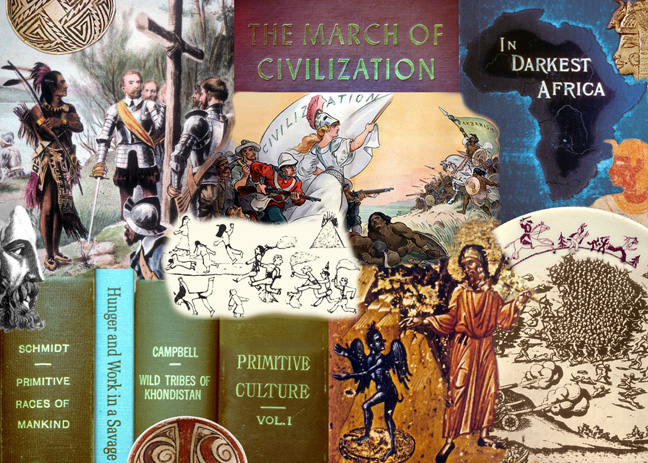
How white supremacist ideology functions as a justification and ongoing template for domination. Narratives of supremacy in textbooks, novels, movies, advertising, comics, public monuments, and maps. Assumptions embedded in naming and language: “the March of Civilization,” “barbarism,” “progress.” What is communicated by phrases like “Old World” and “New World”? What is left out in talk about “The Ancient World,” “the Classics,” “the Canon.” We’ll look at pseudo-scientific race theories: Caucasoids and Others; whitening the Egyptians; stereotypes of Indigenous peoples in the Americas; Black South Asias and Australasians, and how narratives of “vanishing” peoples cover up historical genocides.
Italy Before Romans

The oldest female icons of the paleolithic and forward, from the Riviera to the Alps to Sicily. Megalithic women from Sardinia, Foggia, and Lunigiana. Rock engravings of Val Camonica; breastpots of the Terramare culture, and the Nuraghic bronzes of Sardinia. Tanit stones, the Iblaean Mother, and the rock-cut Santoni in Sicily. In the northeast, stunning bronze discs of the Veneti, and inscriptions offered to their goddess Rehtia. Moving south, the Daunian limestone stelae, mostly women who are tattooed and richly arrayed, and the scenes of weaving and ceremony engraved on them. (The Etruscans are an entire show on their own, so not included here.)
Female Icons, Ancestral Women The ancient female figurines are classic icons of cultures around the world, from the paleolithic into recent time. We explore forms of female potency expressed through these primal images—and what they can tell us about women’s ceremonies long ago — in all their diversity and global relatedness. These images shouldn't be rare or hard to find; but they have been hidden away, which is why it took 50 years to assemble a collection that shows the global scale of this iconography.
Prophetic Women
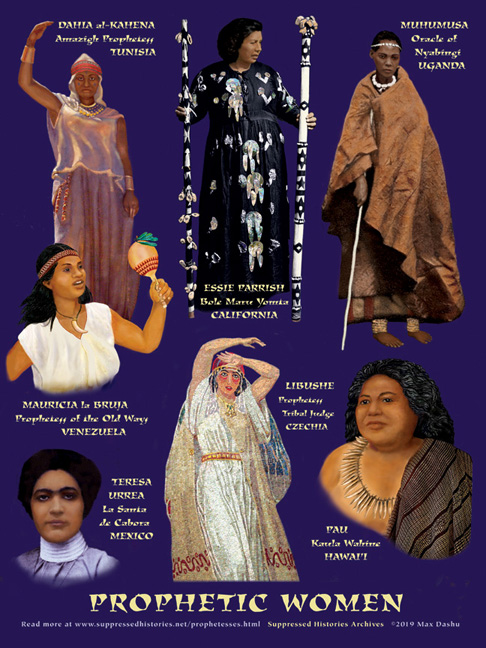
In this international visual journey, we call back into memory the seeress, dreamer, sibyl, oracle. She has many cultural names; but the word “prophetess” comes from the Greek prophemi, “to speak forth, assert, make clear.” Prophecy might be defined as declaring something that cannot be known by ordinary means, or communicating profound insights about the nature of reality. The prophetess does more than “predict the future”; she is a speaker of sacred truths (“soothsayer”) who interprets reality in an inspired voice.
The prophetic woman becomes a channel for wisdom, “sitting out” on a stone, under a tree, beside the river. She is a diviner who casts lots, throws the bones or kernels or shells, and finds remedies and pathways in the dark. She may attain profound states of spiritual inspiration by chanting and dancing, or by abiding in silence.
She is also a guardian of culture, and sometimes a leader who defends her people against invasion and domination. Exemplars like Essie Parrish (California), Dahia al-Kahena (Tunisia), Muhumusa (Uganda), Mauricia la Bruja (Venezuela), and Teresa Urrea (Mexico), known as la Santa de Cabora. We'll talk about Aztec diviners, female oracles from Malawi and Zimbabwe and Greece; Germanic seeresses, Algonquin mashkiki-kwe, French and African-American fortunetellers, the Caribbean madama, and South African izangoma. Most of us have been starved for knowledge about these women, and search ways of knowing that stand beyond the systems of domination, that subvert them, and liberate us.
Suppressed Histories Archives | Articles | Max Dashu
